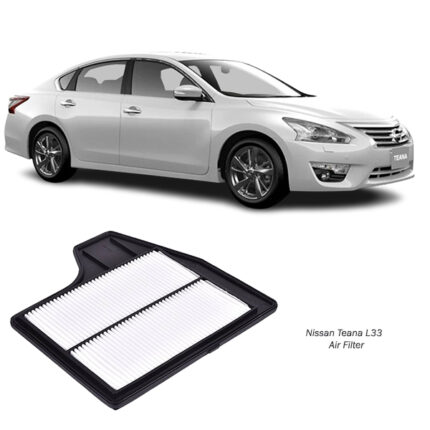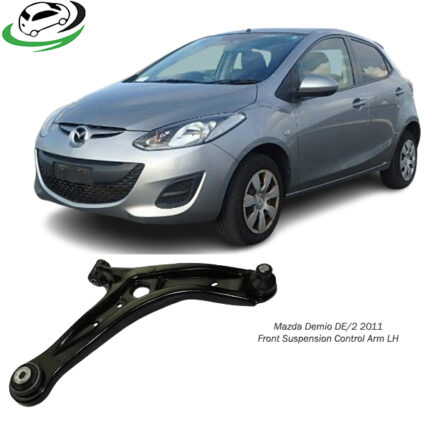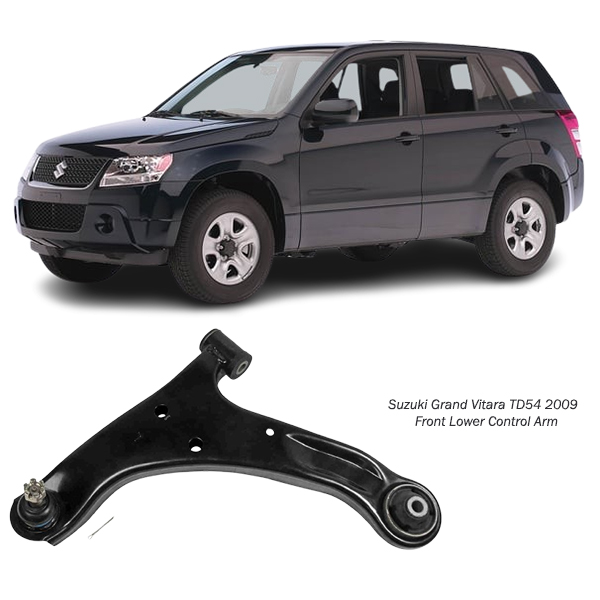-8%
Get Suzuki Grand Vitara TD54 Front Lower Control Arm RH 45202-78K00 in Kenya
The front lower control arm (RH) is a critical component of a vehicle’s suspension system, providing stability, support, and smooth operation. Located on the right-hand (RH) side of the front suspension, it connects the chassis to the wheel assembly. Its design allows for controlled movement of the wheel while maintaining proper alignment and minimizing vibration. In this guide, we’ll explore the design, functions, types, benefits, maintenance, and troubleshooting of the front lower control arm RH in detail.
1. Understanding the Front Lower Control Arm RH
a) Basic Structure
- The lower control arm is typically a triangular or A-shaped metal component.
- Key parts include:
- Chassis Mounting Points: Where it is bolted to the vehicle’s frame.
- Ball Joint: Connects the control arm to the steering knuckle, allowing rotational movement.
- Bushing Mounts: Absorb vibration and noise while enabling controlled motion.
b) Materials Used
- Made of materials like steel, aluminum, or forged alloys for durability and strength.
- Modern control arms may use lightweight composites to enhance performance and fuel efficiency.
2. Functions of the Front Lower Control Arm RH
a) Support and Stability
- Provides a sturdy link between the vehicle’s frame and wheel assembly.
- Helps to evenly distribute weight and road forces.
b) Controlled Wheel Movement
- Allows the wheel to move vertically (up and down) in response to road conditions, ensuring better handling and comfort.
c) Alignment Maintenance
- Keeps the wheel properly aligned with the vehicle’s frame to prevent uneven tire wear and ensure precise steering.
d) Vibration Absorption
- Bushings within the control arm dampen vibrations and reduce noise for a smoother ride.
3. Types of Front Lower Control Arms
a) Stamped Steel Control Arms
- Most common in standard vehicles.
- Cost-effective and durable but heavier than alternatives.
b) Cast Aluminum Control Arms
- Found in high-performance or luxury vehicles.
- Lightweight and corrosion-resistant but more expensive.
c) Forged Control Arms
- Extremely strong and used in heavy-duty vehicles or off-road applications.
- Offers superior resistance to stress and impact.
4. Common Designs of Front Lower Control Arms
a) Single Piece Design
- A solid component without separable ball joints or bushings.
- Easier to install but may require replacement as a unit.
b) Modular Design
- Ball joints and bushings are replaceable.
- Allows for cost-effective repairs and maintenance.
5. Signs of a Worn or Damaged Front Lower Control Arm RH
a) Noisy Operation
- Clunking or banging noises from the suspension during driving indicate worn bushings or ball joints.
b) Poor Steering Response
- Loose or imprecise steering may result from excessive play in the control arm assembly.
c) Uneven Tire Wear
- A misaligned control arm can cause tires to wear unevenly.
d) Vibrations
- Excessive vibrations felt in the steering wheel or cabin may point to worn control arm bushings.
e) Vehicle Pulling to One Side
- A bent or damaged control arm can cause alignment issues, making the vehicle veer off course.
6. Benefits of a Well-Maintained Control Arm
a) Enhanced Handling
- A properly functioning control arm ensures stable and predictable handling, even during sharp turns or uneven terrain.
b) Improved Ride Comfort
- The damping effect of bushings and proper alignment reduce vibrations and noise.
c) Extended Tire Life
- Prevents uneven tire wear by maintaining proper wheel alignment.
d) Increased Safety
- Ensures reliable contact between tires and the road, improving braking and steering performance.
e) Reduced Maintenance Costs
- Timely inspection and repair prevent more expensive damage to suspension and steering components.
7. Maintenance of Front Lower Control Arm RH
a) Inspection Schedule
- Check the control arm during routine vehicle servicing or whenever suspension issues arise.
- Inspect ball joints, bushings, and the arm itself for signs of wear or damage.
b) Cleaning
- Keep the control arm and surrounding components clean to prevent debris from accelerating wear.
c) Bushing Replacement
- Replace worn or damaged bushings to restore proper damping and alignment.
d) Ball Joint Care
- Regularly grease serviceable ball joints, if applicable, to reduce friction and wear.
e) Alignment Checks
- Ensure proper wheel alignment after any suspension work to prevent undue stress on the control arm.
8. Replacement of the Front Lower Control Arm RH
a) Tools Needed
- Jack and jack stands
- Wrenches and sockets
- Torque wrench
- Pry bar
- Ball joint separator
b) Steps to Replace
- Lift the Vehicle: Use a jack and stands to elevate the front of the vehicle securely.
- Remove the Wheel: Detach the wheel to access the control arm.
- Disconnect Ball Joint and Bushings:
- Use a separator to release the ball joint from the steering knuckle.
- Unbolt the bushings from the chassis.
- Detach the Control Arm: Remove any remaining bolts or fasteners and take out the old control arm.
- Install the New Control Arm: Reverse the steps to install the new component, ensuring proper alignment and torque for all bolts.
- Reattach the Wheel and Lower the Vehicle.
- Test Drive: Check for proper operation and alignment after replacement.
9. Cost of Replacement
a) Price of the Control Arm
- Costs vary based on material and brand:
- Steel: $50-$150
- Aluminum or forged: $150-$300+
b) Labor Costs
- Professional replacement may cost $100-$300 depending on labor rates and complexity.
c) Total Costs
- DIY replacements save on labor but require tools and expertise.
10. Troubleshooting Issues
a) Persistent Noises
- Ensure bolts are tightened to specification.
- Inspect nearby suspension components for additional wear.
b) Alignment Problems
- Perform a wheel alignment after replacing the control arm.
c) Premature Wear
- Use high-quality parts and avoid aggressive driving to extend the lifespan of the control arm.
11. Longevity and Durability
a) Expected Lifespan
- Control arms typically last 90,000-100,000 miles under normal conditions.
b) Factors Influencing Durability
- Driving habits: Aggressive driving or frequent off-road use accelerates wear.
- Environmental conditions: Corrosion from road salt can weaken components.
- Quality of parts: OEM or premium aftermarket parts offer better durability.
12. Innovations in Control Arm Technology
a) Lightweight Materials
- Use of composites or advanced alloys for reduced weight and improved fuel efficiency.
b) Advanced Bushings
- Hydro or elastomer bushings for enhanced vibration damping.
c) Adjustable Control Arms
- Allow for fine-tuning suspension geometry in performance applications.
13. Conclusion
The front lower control arm RH is vital for a vehicle’s suspension system, contributing to stability, handling, and comfort. Regular inspection, proper maintenance, and timely replacement of worn components ensure optimal performance and safety. Whether for daily commutes or challenging driving conditions, understanding and caring for the control arm can significantly enhance the driving experience.
Follow us on Facebook for more parts.



